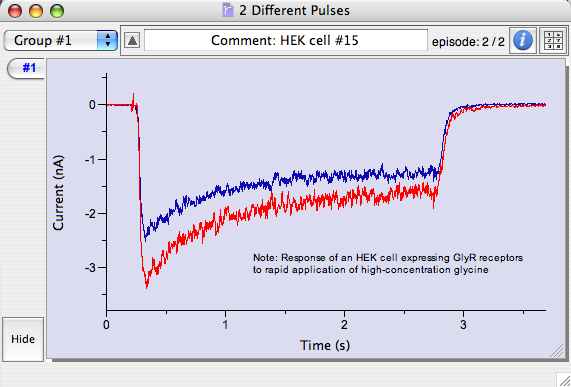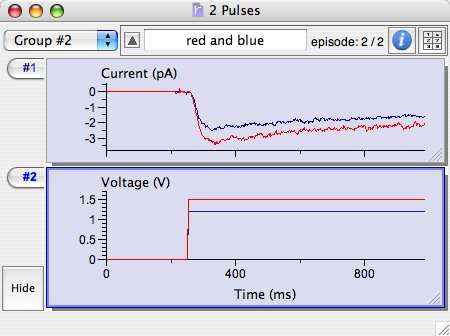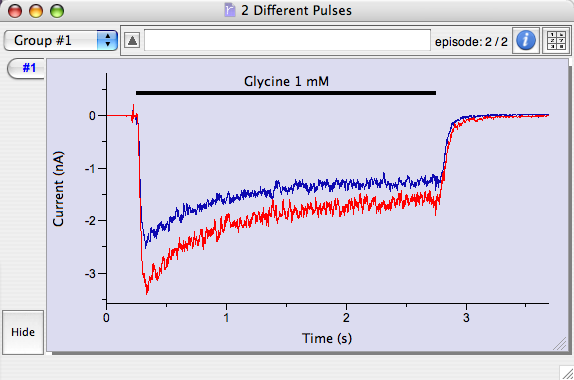How to run AxoGraph under MacOS Catalina
Unfortunately Apple dropped support for 32-bit apps when it released MacOS Catalina (10.15). This has affected many older apps, including AxoGraph (more than 20 years since it was first released).
However, if you need to work with Catalina as your primary OS, there are a couple of practical work-around for running AxoGraph, and any other 32-bit apps you rely on.
1) You could purchase an external SSD drive, install Mojave 10.14, and make it bootable. You would reboot when you needed to run AxoGraph, or other 32 bit apps. This would be the preferred option if you needed to perform data acquisition using AxoGraph.
https://www.youtube.com/watch?v=kdzK5lgqLjM
2) You could use Parallels (parallels.com) to create a virtual machine and install Mojave 10.14, or High Sierra 10.13. Parallels is very slick, and you can launch and run 32-bit apps seamlessly under Catalina, and even copy and paste from a 32-bit app into a Catalina 64-bit app. Of course there is a performance hit, so this approach is only recommend on a fast computer with plenty of disk space and RAM.
A new Parallels license is only ~US$50, and you could have Mojave / AxoGraph installed in an hour or so, depending on your broadband speed. Here’s some guidance about the process…
https://au.pcmag.com/vmware-fusion-8-for-mac/63913/how-to-run-32-bit-apps-in-macos-catalina
To complete either of these suggested work-arounds, you may need to download a macOS installer
https://apps.apple.com/us/app/macos-mojave/id1398502828?mt=12
https://apps.apple.com/us/app/macos-high-sierra/id1246284741
There’s also the option of using the free open source VirtualBox instead of Parallels, https://www.virtualbox.org, and there are how-to YouTubes on setting it up. However, this approach is not recommended as there's more work involved, and it’s not so smoothly integrated with Catalina.
-----------------
Catalina has re-energised our efforts to finish the new, completely re-written 64-bit version of AxoGraph. It’s a huge task AxoGraph consists of approx 100,000 lines of code (think of a book with 100 lines per page, and 1,000 pages). These need to be moved across to a new development framework. Some algorithms come across unchanged, but the user interface has been re-written from scratch. The project is not far from completion (about 70% done).
There is no definite time-line. The plan from here is to release a new data-acquisition-only version, which will initially support HEKA and National Instruments and Molecular Devices digitizers. Data analysis features will be added in a subsequent update.
A Tour of AxoGraph's Main Features
Overview
Cross-Platform, Multi-Vendor and Inexpensive
AxoGraph is a scientific data acquisition and analysis application that runs on both Mac OS and Windows. It supports digitizers and amplifiers from many companies. For the budget-conscious, it provides one of the cheapest solutions for neuroscience research.
Easy to Use
AxoGraph was designed by an active research scientist and refined over years of laboratory use. It places frequently used features at your fingertips. It excels at browsing, organizing and analyzing episodic data.
Analysis
A wide variety of event-detection, measurement, curve-fitting, and statistical analysis features are available. Analysis can be customized (including real-time analysis during data acquisition). Repetitive tasks can be automated.
Acquisition
A sophisticated data acquisition system records electrical signals, while delivering complex output waveforms. It supports hardware from a range of manufacturers. It features...
- protocol-driven acquisition
- real-time analysis as data is acquired
- patch clamp test pulse with seal resistance calculation
- continuous or episodic acquisition
Past and Future
Development of AxoGraph began in 1990, and it is being used today in research labs around the world (Harvard, Yale, NIH, Salk, Columbia, Oxford, Cambridge, UCL, Max-Planck, ENS, ANU, NIPS, etc.).
A complete rewrite is underway which will rejuvenate and future-proof AxoGraph. Many new and improved features are planned for 2017 and beyond.
Technical Support
Contact
Technical Support Enquiries
Support: This email address is being protected from spambots. You need JavaScript enabled to view it.
Lead Programmer: This email address is being protected from spambots. You need JavaScript enabled to view it.
Sales Enquiries
Support: This email address is being protected from spambots. You need JavaScript enabled to view it.
Enquiries about Payment Methods or an Existing Order
Contact our e-commerce partner, Avangate: 24-7 customer support.

AxoGraph Developer,
Dr John Clements
Purchase an AxoGraph License
License Types
There are Two Types of AxoGraph License :
- Lab (data acquisition and analysis)
- Office (analysis only)
A 'Lab' license includes all the features of an 'Office' license.
Each license permits use of AxoGraph on a single computer.
A license can be moved between computers using the 'AxoGraph License Manager' application.
Feature Overview
(A more detailed feature list is available here)
Lab
- Chart recorder
- Digital oscilloscope
- Protocol-driven episodic acquisition with complex output waveforms
- Electrophysiology tools
- Test pulse measures electrode resistance, cell capacitance and membrane resistance
- P/N leak subtraction for voltage-clamp step protocols
- Digitizers currently supported:
- HEKA LIH 8+8 - this is the recommended digitizer to use with AxoGraph
- Instrutech (ITC-1600, ITC-16, ITC-18, USB-16 and USB-18)
- Molecular Devices Digidata 1440A (Windows XP only)
- Molecular Devices Digidata 1320A, 1321A and 1322A (Windows XP and OS X)
- National Instruments Multifunction I/O Devices (Windows XP full support: OS X partial support)
- A Lab license incorporates all the features of an Office license
Office
- Data analysis
- Point and click measurement
- Automatic peak measurement
- Curve fitting
- Statistics
- Much more...
- Graphics
- Easily browse and reorganize data
- Many scientific graph styles
- Export to presentation and page layout programs
- Event detection package
- useful for analyzing spontaneous events, including minis (mPSPs, mPSCs) and action potential field recordings
- shape recognition options - sort events into different shape categories
- reliable detection under low signal-to-noise conditions
- Electrophysiology analysis and modeling
- Automated I-V curves
- Variance-mean analysis
- Model synaptic amplitude fluctuations
- Receptor/channel modeling (aka chemical-kinetic or Markov model)
- Voltage- and ligand-gated channels
- Stochastic mode for single-channel simulations
Purchase an AxoGraph License
Order Now
Sales of AxoGraph licenses have been suspended until technical issues with the license server are resolved.



